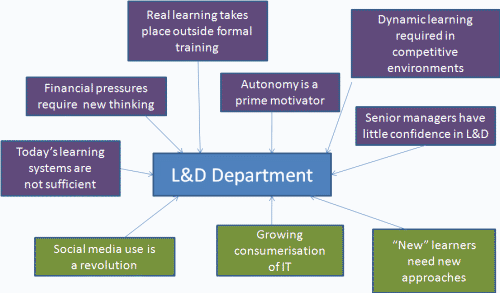Being an association professional development practitioner can be tough…month after month, year after year, you’re tasked with coming up with content and speaker ideas for education programs. It’s easy to fall into a routine and it can be tough to implement breakthrough ideas and concepts when the existing event model and planning cycle is entrenched.
Evidence is growing, however, that the current model needs breakthrough ideas…maybe even a complete overhaul.
Consider:
• In a post titled “Take This LMS and Shove It,” Gary Wise (Living in Learning) quotes Josh Bersin: the average knowledge worker spends less than 5% of working hours in formal learning opportunities. Organizations spend as much of 80% of their learning resources on this 5%. So, workers [members] are spending 95% of their time in a work context – where informal learning flourishes. I’ll add to that: we repeatedly hear what is almost a conference axiom: the best conference learning happens in the hallways. There’s a reason it does.
• In her constantly evolving, multi-website resource, Jane Hart (Centre for Learning & Performance Technologies) identified 10 factors driving change in workplace learning (see graphic at right). These factors apply to association learning too; especially the idea that our heavy emphasis on designing content-driven events is an outmoded industrial-age model insufficient for today’s learning needs.
• In their book The 2020 Workplace, authors Jeanne Meister and Karie Willyerd made 10 predictions for learning for the decade between 2010 and 2020. Associations have a leg-up over corporations with at least a couple of those predictions:
> Peer-to-peer learning blossoms – we’ve had peer-to-peer learning in associations for years; in some cases it’s becoming less structured as members take more responsibility for finding and creating their own learning opportunities.
> Expert & credibility ratings create trusted search networks – search is evolving, and with so much information available we’ll need to know who to trust for information. Who better than our associations and fellow members in those associations?
• Books like Brain Rules by John Medina and Evidence-Based Training Methods by Ruth Clark are blowing up some of what we thought we knew about how to engage learners effectively. For example, Clark says “learning styles represent one of the more wasteful and misleading pervasive myths of the past 20 years,” and provides the evidence to prove it. She later goes on to admonish, “if you make one change as a result of reading this book, give up the learning style myth.” [emphasis Clark’s]
• With all the hoopla over using social media within learning experiences, we forget that learning has always been social. What’s different, according to Tony Bingham and Marcia Conner in their book, The New Social Learning, is the convergence of three trends: (1) expanding opportunities for personal connection; (2) emerging expectations from shifting workforce demographics; and (3) the increasing reach of customized technology.
Despite everything we hear about the new and revolutionary ways of doing things, some things just don’t change. Basic adult learning principles — including learner engagement — have been around for decades and still stand the test of time. In fact, they fit quite nicely into social learning and the increasing calls for greater levels of learner engagement in association professional development.
This post is taken from my learning lab at ASAE’s annual meeting in August 2010, entitled “Leading-Edge Learning: Thinking ‘Different’ About Learner Engagement.”